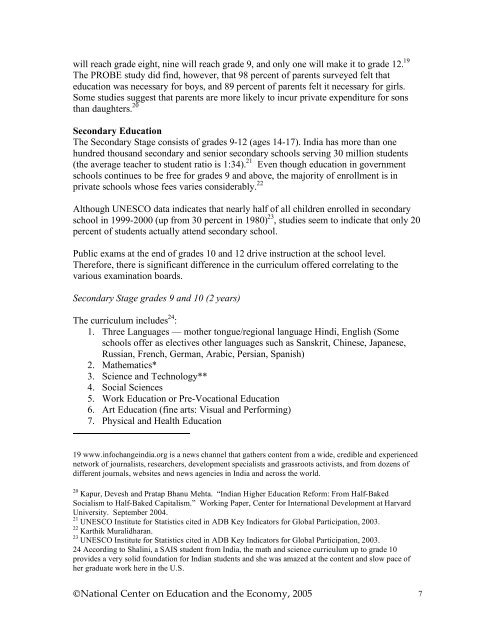India Education Report (2005) - NCEE
India Education Report (2005) - NCEE
India Education Report (2005) - NCEE
Create successful ePaper yourself
Turn your PDF publications into a flip-book with our unique Google optimized e-Paper software.
will reach grade eight, nine will reach grade 9, and only one will make it to grade 12. 19<br />
The PROBE study did find, however, that 98 percent of parents surveyed felt that<br />
education was necessary for boys, and 89 percent of parents felt it necessary for girls.<br />
Some studies suggest that parents are more likely to incur private expenditure for sons<br />
than daughters. 20<br />
Secondary <strong>Education</strong><br />
The Secondary Stage consists of grades 9-12 (ages 14-17). <strong>India</strong> has more than one<br />
hundred thousand secondary and senior secondary schools serving 30 million students<br />
(the average teacher to student ratio is 1:34). 21 Even though education in government<br />
schools continues to be free for grades 9 and above, the majority of enrollment is in<br />
private schools whose fees varies considerably. 22<br />
Although UNESCO data indicates that nearly half of all children enrolled in secondary<br />
school in 1999-2000 (up from 30 percent in 1980) 23 , studies seem to indicate that only 20<br />
percent of students actually attend secondary school.<br />
Public exams at the end of grades 10 and 12 drive instruction at the school level.<br />
Therefore, there is significant difference in the curriculum offered correlating to the<br />
various examination boards.<br />
Secondary Stage grades 9 and 10 (2 years)<br />
The curriculum includes 24 :<br />
1. Three Languages — mother tongue/regional language Hindi, English (Some<br />
schools offer as electives other languages such as Sanskrit, Chinese, Japanese,<br />
Russian, French, German, Arabic, Persian, Spanish)<br />
2. Mathematics*<br />
3. Science and Technology**<br />
4. Social Sciences<br />
5. Work <strong>Education</strong> or Pre-Vocational <strong>Education</strong><br />
6. Art <strong>Education</strong> (fine arts: Visual and Performing)<br />
7. Physical and Health <strong>Education</strong><br />
19 www.infochangeindia.org is a news channel that gathers content from a wide, credible and experienced<br />
network of journalists, researchers, development specialists and grassroots activists, and from dozens of<br />
different journals, websites and news agencies in <strong>India</strong> and across the world.<br />
20 Kapur, Devesh and Pratap Bhanu Mehta. “<strong>India</strong>n Higher <strong>Education</strong> Reform: From Half-Baked<br />
Socialism to Half-Baked Capitalism.” Working Paper, Center for International Development at Harvard<br />
University. September 2004.<br />
21 UNESCO Institute for Statistics cited in ADB Key Indicators for Global Participation, 2003.<br />
22 Karthik Muralidharan.<br />
23 UNESCO Institute for Statistics cited in ADB Key Indicators for Global Participation, 2003.<br />
24 According to Shalini, a SAIS student from <strong>India</strong>, the math and science curriculum up to grade 10<br />
provides a very solid foundation for <strong>India</strong>n students and she was amazed at the content and slow pace of<br />
her graduate work here in the U.S.<br />
©National Center on <strong>Education</strong> and the Economy, <strong>2005</strong> 7


